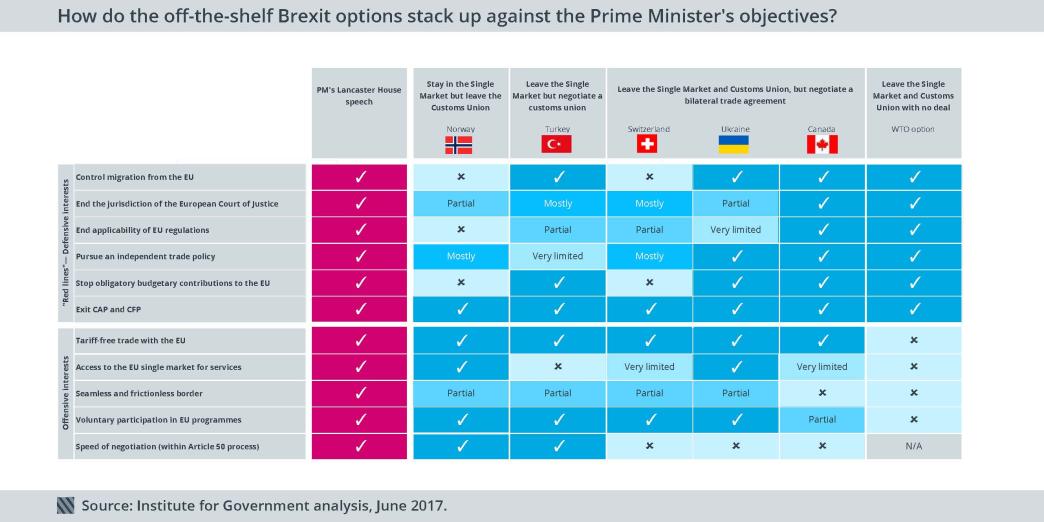The options for the UK’s trading relationship with the EU
The difference between the four basic options for the UK’s trading relationship with the EU.

Why are people talking about this (again)?
The UK and EU are set to begin trade talks after the European Council in March 2018. The two sides hope to agree a framework for their future relationship by October, which will inform the passage of the withdrawal agreement in the European Parliament and the UK Parliament.
Ahead of these talks, the UK is being pressed to set out what it wants this future relationship to be.
The Prime Minister has made two speeches, setting out her vision for Brexit: the Lancaster House speech in January 2017, and then her Florence Speech in September 2017. Both speeches made it clear that UK plans to leave the EU Single Market and the Customs Union. But neither went in to detail on what relationship the UK would like to negotiate in place of the current EU membership.
Groups in Parliament are arguing for the need to “soften” Brexit, and to give more priority to the economy over cutting migration or insisting on leaving the jurisdiction of the European Court of Justice (ECJ). The Scottish Conservative leader, Ruth Davidson, has argued for an “open Brexit”, while Chancellor Phillip Hammond has called for a “pragmatic Brexit”.
Others, including George Osborne and Nigel Farage, say that the Norway option of leaving the EU but joining the European Economic Area (EEA) might be on the cards. Daniel Hannan MEP suggests that we could follow the Swiss model of multiple bilateral deals. Some business people argue for staying in the EU Customs Union, at least in the short term, to avoid the cliff edge and minimise disruption to supply chains.
How do those options stack up against the Prime Minister’s objectives?
The table below compares the main options, based on existing arrangements the EU has with other countries – and the option of leaving the EU with “no deal” in place. It looks at how the potential future deals would compare with the Prime Minister’s red lines, and what they might mean for the UK’s ambition to maintain “the freest possible trade” and “as seamless trade as possible” with the EU.

The main points to note are:
1. Norway option: Staying in the EU Single Market and leaving the Customs Union would mean full access to the Single Market for both goods and services, but the UK would have to continue to abide by the EU’s four freedoms, including freedom of movement. It would have to accept the EU acquis and regulations, without having a say on what those rules might look like in the future. The UK would be subject to the European Free Trade Association Court (EFTA) rather than the ECJ (though that court follows ECJ judgements). The UK would be free to pursue its own independent trade policy, though in practice Norway, along with other countries in the EFTA, often negotiate as a bloc.
2. Turkey option: Leaving the EU Single Market and EU Customs Union, but creating a new customs union with the EU. This would ensure tariff-free trade for goods covered by new customs union, but mean applying the EU’s common external tariff for trade to those goods imported from other countries. Following the Turkey model would eliminate most checks and controls for industrial goods, but would still mean businesses had to comply with varied border documentation, which does not lead a seamless and frictionless border. Accepting the EU’s common external tariff would also constrain the UK’s ability to strike new trade deals and require the UK to comply with substantial numbers of EU products regulations.
3. Leaving the Single Market and Customs Union, but negotiating a new bespoke bilateral free trade and customs agreement. This is what the Prime Minister and David Davis want to do. Three potential models that could form the basis of such an agreement are:
- Swiss option: Multiple bilateral deals: Switzerland has a bespoke arrangement with the EU, based on more than 120 bilateral agreements developed over the last two decades. The Swiss have tariff-free trade with the EU and limited access to the EU Single Market for services. In return, however, the Swiss accept free movement of people and comply with the EU’s regulations in relation to the parts of the Single Market they access, without having a say on what those rules look like. They can pursue an independent trade policy, though in practice they often negotiate together with other EFTA countries.
- Ukraine option: Deep and Comprehensive Trade Area. Ukraine’s association agreement with the EU provides for nearly-full access to the Single Market through a special arrangement designed as a potential first step towards full EU membership. This provides Ukraine with an unprecedented market access for goods and services, particularlu financial services. Ukraine must abide by the EU’s regulations and acquis, but there is no free movement of people. This arrangement also covers issues going beyond trade, such as security cooperation.
- Canada option: A Comprehensive Economic and Trade agreement: The EU’s new agreement with Canada allows tariff-free trade with the Single Market for industrial goods and some agricultural produce but very limited access for services. Canada does not have to comply with the EU’s regulations, but there is mutual recognition where each side accepts the other countrie’s regulations for market access to some services. It can lead its own trade policy but that means customs controls and compliance with the “rules of origin” checks.
4. World Trade Organization (WTO) option: Leaving the Single Market and Customs Union without a deal. The final option would be for the UK to leave with no future trade agreement. The UK would revert to trading with the bloc of 27 member states on WTO terms, meaning that both the EU and UK would apply tariffs to trade between them. With no agreement on regulatory equivalence between the EU and UK, there would be no preferential access to the EU market for services. There would also be no flanking bilateral agreements to ease the flow of trade – an unparalleled situation given that no major country trades with the EU on WTO terms alone.
So, which option?
All of these options need to be weighed for political acceptability, short- and long-run economic impact, and depend on the willingness of the EU-27 to agree a deal on this sort of basis with the UK. Some may also form the basis for a transitional arrangement while the UK and EU negotiate a long-term deal or while the UK implements the systems to manage its new relationship with the EU.
- Topic
- Brexit